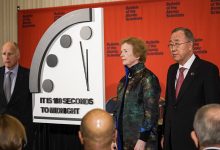The world has inched closer to existential threats, with The Bulletin of the Atomic Scientists moving its “Doomsday Clock” to 100 seconds to midnight, citing the inadequate response to climate change from governments as one of the key threats to humanity.
The clock, which features on the cover of the Bulletin’s magazine, was moved closer to midnight and to within “2 minutes” for the first time in its history, with the Bulletin warning of two simultaneous threats to humanity: climate change and nuclear war.
“Humanity continues to face two simultaneous existential dangers — nuclear war and climate change — that are compounded by a threat multiplier, cyber-enabled information warfare, that undercuts society’s ability to respond,” the Bulletin said in a statement.
“The international security situation is dire, not just because these threats exist, but because world leaders have allowed the international political infrastructure for managing them to erode.”
Bulletin president Rachel Bronson channelled Swedish climate activist Greta Thunberg at the announcement, saying she hoped that the renewed warning would spur governments to act, highlighting the fact that governments are running out of time to implement the policies necessary to limit global warming to levels that would avoid the worst impacts of climate change.
“As far as the Bulletin and the Doomsday Clock are concerned, the world has entered into the realm of the two-minute warning, a period when danger is high and the margin for error low.”
“The moment demands attention and new, creative responses. If decision makers continue to fail to act—pretending that being inside two minutes is no more urgent than the preceding period—citizens around the world should rightfully echo the words of climate activist Greta Thunberg and ask: ‘How dare you?’”, Bronson said.
The Bulletin said that while the world had gained an increased awareness of the threat posed by climate change, created by youth-led student strikes around the world, but was disappointed that governments had failed to match these calls with action.
“At UN climate meetings last year, national delegates made fine speeches but put forward few concrete plans to further limit the carbon dioxide emissions that are disrupting Earth’s climate. This limited political response came during a year when the effects of manmade climate change were manifested by one of the warmest years on record, extensive wildfires, and quicker-than-expected melting of glacial ice,” the statement said.
Australia was singled out for the federal government’s regressive stance on climate change, with the executive chair of the Bulletin’s Science and Security Board Jerry Brown, who previously served as the Governor of California between 1975 and 1983 and again between 2011 and 2019.
“The Australian government is in utter and complete denial. Under its current leadership, Australia is fostering denial in an incredibly mendacious way.”
The warning follows an editorial published by the prestigious scientific journal Nature, which likewise singled out the Australian government, and prime minister Scott Morrison, to demand greater leadership and increased ambition on climate change action.
“The Morrison government has to make a choice: does it want Australians to live with fires that are becoming worse than those in the past but which can still be managed to some extent? Or does it want to put citizens at risk of future fire conditions that are even more catastrophic than this season’s?”
“There can be only one answer to this question if the government accepts that its first role is always to protect its citizens and its country,” the Nature editorial said.
The Bulletin of the Atomic Scientists first published the Doomsday Clock in 1947 as a way of issuing a warning of the potential imminent threat of manmade disasters to humanity and has primarily focused on the threat of nuclear war.
It reached ‘two minutes to midnight’ for the first time in 1953, the previous record, following United States tests of thermonuclear weapons.
In recent years, the Bulletin of the Atomic Scientists has included climate change in its threat assessment and has been a contributing factor to the clock moving to its closest position to ‘midnight’ in its more than 70 years of existence.










